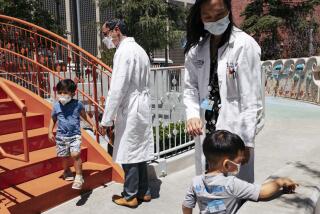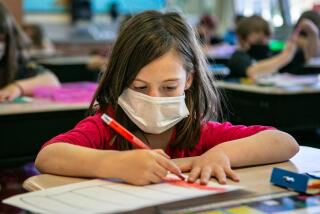Prompt Pneumonia Care Key for Children
- Share via
Of all the diseases in the world, none threatens humanity’s youngest, most fragile members more than the grab bag of lung infections known as pneumonia.
True, heart disease is now the No. 1 killer of people worldwide, despite the continuing scourge of AIDS, malaria and other deadly infectious diseases. And smoking is projected to be the No. 1 contributor to death by the year 2020.
But pneumonia, because it kills so many of the world’s babies and children, is the disease that robs the human race of the most years of life. It kills close to 2 million children under age 5 each year, by far the most of them in the developing world. And it outstrips the other four main killers of this age group--diarrhea, measles, malaria and malnutrition--which together cause 70% of all childhood deaths worldwide.
This doesn’t have to happen, says Dr. Jim Tulloch, director of the department of child and adolescent health and development at the World Health Organization in Geneva.
“It’s not a matter of the treatments being too complex, or expensive,” he says. “It’s really a matter of access to simple, good quality care. Most of these children could be treated with affordable antibiotics that would cost certainly less than a dollar for a full course of treatment.”
But too often, he says, families don’t have access to basic health care, or parents--often out of concern for the cost--delay taking their child to the doctor. Health care workers, meanwhile, may not recognize the early symptoms of pneumonia. Thus, a milder infection gets a chance to develop into a more serious condition.
The delay can be deadly.
Children in poorer parts of the world also are more at risk from developing pneumonia to begin with, Tulloch says. They often live in crowded, unsanitary conditions where germs can flourish. And they are often malnourished, and thus their bodies are weaker and their immune systems less able to fight off disease. This means that upper-respiratory infections that in well-fed children would rarely develop into pneumonia can spread to their lungs and kill them. Indoor air pollution, from smoky wood-burning stoves used for cooking and heating the home, also contributes to the pneumonia death toll, by somehow rendering the children’s lungs more susceptible to infection.
*
The WHO is now battling to change these grim statistics via a three-part strategy known as “Integrated Management of Childhood Illness.” Fifty-eight countries are participating.
Goal No. 1 (for pneumonia): Heighten the health care worker’s awareness of key symptoms, without relying on X-rays and lab tests that might not be available. If a child arrives at the clinic with a cough, check his breathing rate. If it’s fast, the child likely has pneumonia and needs oral antibiotics. If the soft tissue below the child’s ribs is being sucked in each time the child breathes, that’s a sign that the condition is advanced and the child needs to go to the hospital.
Goal No. 2: Educate parents: to take their child to the health care worker, without delay, if that child develops a cough; to give their child an entire course of antibiotics instead of stopping when the symptoms go away; and to take the child back to the clinic if symptoms return.
“Most respiratory infections aren’t going to kill a child, but parents need to recognize that some of them could quite quickly lead to death,” Tulloch says.
Goal No. 3: Improve access to the drugs and other medical tools that health workers need.
Pneumonia, or infection and inflammation of the lungs, can be caused by more than 30 types of bugs: bacteria, viruses, strange small microbes called mycoplasmas, and fungi. About half the infections are viral, which aren’t treatable by antibiotics, but these are generally left to go away on their own.
The bugs are on, in and around us all the time--some even live in our throats--waiting for a time when they can crash past our defenses and invade.
Once inside our lungs, they clog up the tiny air sacs, called alveoli, that we need to breathe. Our body’s responses add to the problem, by clogging the sacs still further with fluid and bug-fighting cells, and triggering inflammation. Sometimes, the infection spreads from the lung into the rest of the body, which also can kill.
*
In recent years, doctors have become alarmed by strains of pneumonia-causing bacteria that are resistant to most of the antibiotics we rely upon. These are especially common in the kind of pneumonia picked up in hospitals, where there’s a lot more exposure to antibiotics, but they are cropping up in so-called “community pneumonias” as well.
Though this is a serious concern, Tulloch says, most of the worldwide pneumonia deaths aren’t due to resistant strains, just lack of proper care.
Nor is the developing world taking advantage yet of vaccines against some of the most common types of pneumonia-causing bacteria. Research to determine whether the vaccines are effective in different parts of the world--the vaccines will only work against certain bacteria, after all--has been slow in coming, Tulloch says.
Money is one big reason why.
“If there had been more money available, the research could have been going on in parallel with research in developed countries, and there wouldn’t have been this time lag,” he says. “We need to cut this delay of availability of treatments between richer and poor children.”
Still, there’s evidence that deaths from pneumonia are declining, says Dr. Christopher Murray, director of the global program on evidence for health policy at the WHO. All over the world, childhood mortality is declining, even in sub-Saharan Africa, where another huge killer, malaria, continues to kill one in five children.
“We don’t think malaria is going down. It may even be going up,” Murray says. “If the child death rate can decline even in the face of that, pneumonia is probably going down.”
The likely reason, he adds, has nothing to do with those countries getting richer.
“We know that the economies of sub-Saharan Africa have not improved at all this decade,” he says. “But a mother’s education has profound influences on child mortality, from her responsiveness to her child in the home, to how quickly she seeks care. The past investment of education in these countries is probably why mortality can decline even in the face of stagnant economics.”
More to Read
Sign up for Essential California
The most important California stories and recommendations in your inbox every morning.
You may occasionally receive promotional content from the Los Angeles Times.













